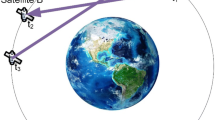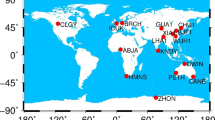Abstract
The third generation of the BeiDou navigation satellite system (BDS-3) has accomplished a complete constellation with 30 BDS-3 satellites in 2020. All of the BDS-3 satellites are equipped with Ka-band inter-satellite link (ISL) payloads, which have the capability for inter-satellite measurement and communication. With the support of ISL, autonomous navigation for BDS-3 satellites can be achieved. In this contribution, we develop an on-board centralized autonomous navigation processing schedule for BDS-3 satellites. Unlike traditional batching mode, we adopt an extended Kalman filter (EKF) to estimate the satellite’s orbit and clock parameters using two independent filters to ensure real-time performance, in each of which we simultaneously estimate all satellites' orbit or clock parameters in a centralized processing mode. From the view of engineering, we also optimize the algorithm to reduce the computing load and resource usage of the on-board satellite’s processor. The proposed approach is validated using ISL observations in an 85-day period from 18 BDS-3 satellites, and a comprehensive evaluation was conducted from orbit accuracy, clock accuracy, and positioning performances. The results demonstrate that an average root-mean-square (RMS) of 0.60-m orbit-only user range error (URE) can be achieved, and the average RMS of 2-h predicted orbit URE is 0.65 m. For time synchronization, the average RMS of clock errors is better than 0.3 ns, and the average RMS value of 2-h predicted clock errors is better than 0.6 ns. The standard point positioning (SPP) results show that the estimated orbit and clock by autonomous navigation can meet the requirements of meter-level navigation and positioning for more than 60 days without the support of the ground OCS.




















Similar content being viewed by others
Data availability
The estimated orbits and clocks are available upon request, while the associated original ISL data that support the findings of this study are restricted for distribution.
References
Abusali PAM, Tapley BD, Schutz BE (1998) Autonomous navigation of global positioning system satellites using cross-link measurements. J Guid Control Dyn 21(2):321–327. https://doi.org/10.2514/2.4238
Ananda MP, Bemstein H, Cunlllgham KE, Feess WA, Stroud EG (1990) Global positioning system (GPS) autonomous navigation. IEEE Locat Navig Sym 27(1):497–508. https://doi.org/10.1109/PLANS.1990.66220
Arnold D, Meindl M, Beutler G, Dach R, Schaer S, Lutz S, Prange L, Sośnica K, Mervart L, Jäggi A (2015) CODE’s new solar radiation pressure model for GNSS orbit determination. J Geod 89:775–791. https://doi.org/10.1007/s00190-015-0814-4
Böhm J, Niell A, Tregoning P, Schuh H (2006) Global Mapping Function (GMF): a new empirical mapping function based on numerical weather model data. Geophys Res Lett 33:L07304. https://doi.org/10.1029/2005GL025546
Dick WR, Richter B (2004) The international earth rotation and reference systems service (IERS). In: Heck A (eds) Organizations and strategies in astronomy. Astrophysics and space science library, vol 310. Springer, Dordrecht. https://doi.org/10.1007/978-1-4020-2571-6_8
Fernández FA (2011) Inter-satellite ranging and inter-satellite communication links for enhancing GNSS satellite broadcast navigation data. Adv Space Res 47(5):786–801. https://doi.org/10.1016/j.asr.2010.10.002
Fisher SC, Ghassemi K (1999) GPS IIF-The next generation. Proc IEEE 87(1):24–47. https://doi.org/10.1109/5.736340
Gong X (2017) Parameter integration filter and parameter decomposition filter for autonomous navigation of BDS. GPS Solut 21(3):1405–1416. https://doi.org/10.1007/s10291-017-0640-7
Guo J, Xu X, Zhao Q, Liu J (2016) Precise orbit determination for quad-constellation satellites at Wuhan University: strategy, result validation, and comparison. J Geod 90:143–159. https://doi.org/10.1007/s00190-015-0862-9
Guo L, Wang F, Gong X, Sang J, Liu W, Zhang W (2020) Initial results of distributed autonomous orbit determination for Beidou BDS-3 satellites based on inter-satellite link measurements. GPS Solut 24(3):72. https://doi.org/10.1007/s10291-020-00985-0
Johnston G, Riddell A, Hausler G (2017) The international GNSS service. Springer handbook of global navigation satellite systems. Springer, Cham, pp 967–982. https://doi.org/10.1007/978-3-319-42928-1_33
Klobuchar JA (1987) Ionospheric time-delay algorithms for single-frequency GPS users. IEEE T Aero Elec Sys AES 23(3):325–331. https://doi.org/10.1109/TAES.1987.310829
Luba O, Boyd L, Gower A, Crum J (2005) GPS III system operations concepts. IEEE Aerosp Electron Syst Mag 20(1):10–18. https://doi.org/10.1109/MAES.2005.1396789
Menn MD, Bernstein H (1994) Ephemeris observability issues in the global positioning system (GPS) autonomous navigation (AUTONAV). In: IEEE position location and navigation symposium. https://doi.org/10.1109/PLANS.1994.303376
Montenbruck O, Gill E (2000) Satellite orbits: models, methods and applications. Springer, Berlin
Montenbruck O, Steigenberger P, Prange L, Deng Z, Zhao Q, Perosanz F, Romero I, Noll C, Stürze A, Weber G, Schmid R, Macleod K, Schaer S (2017) The multi-GNSS experiment (MGEX) of the international GNSS service (IGS)—achievements, prospects and challenges. Adv Space Res 59:1671–1697. https://doi.org/10.1016/j.asr.2017.01.011
Pan J, Hu X, Zhou S, Tang C, Guo R, Zhu L, Tang G, Hu G (2018) Time synchronization of new-generation BDS satellites using inter-satellite link measurements. Adv Space Res 61(1):145–153. https://doi.org/10.1016/j.asr.2017.10.004
Pasynkov V, Sadovnikov M, Sumerin V, Shargorodskiy V (2013) The concept and preliminary results of use of satellite laser ranging for GLONASS accuracy improvement. In: 18th international workshop on laser ranging. https://cddis.nasa.gov/lw18/docs/papers/Session4/13-02-10-Pasinkov.pdf
Pavlis NK, Holmes SA, Kenyon SC, Factor JK (2012) The development and evaluation of the earth gravitational model 2008 (EGM2008). J Geophys Res Solid Earth 1978–2012:117. https://doi.org/10.1029/2011JB008916
Pearlman MR, Noll CE, Pavlis EC, Lemoine FG, Combrink L, Degnan JJ, Kirchner G, Schreiber U (2019) The ILRS: approaching 20 years and planning for the future. J Geodesy 93(11):2161–2180. https://doi.org/10.1007/s00190-019-01241-1
Pearlman Pearlman MR, Degnan JJ, Bosworth JM (2002) The international laser ranging service. Adv Space Res 30(2):135–143. https://doi.org/10.1016/S0273-1177(02)00277-6
Rajan JA, Orr M, Wang P (2003a) On-orbit validation of GPS IIR autonomous navigation. In: Proceedings of ION AM 2003a, institute of navigation, albuquerque, NM, USA, June 23–25, pp 411–419
Rajan JA, Brodie P, Rawicz H (2003b) Modernizing GPS autonomous Navigation with anchor capability. In: Proceedings of ION GPS/GNSS 2003b, Portland, Oregon, September 2003b, pp 1534–1542
Rajan JA (2002) Highlights of GPS IIR autonomous navigation. In: Proceeding of the 58th annual meeting of ION and CIGTF 21st guidance test symposium. IEEE, Albuquerque, NM, pp 354–363
Saastamoinen J (1973) Contributions to the theory of atmospheric refraction—part II. Refraction corrections in satellite geodesy. Bull Géod 107:13–34. https://doi.org/10.1007/BF02522083
Song X, Mao Y, Feng L et al (2017) The preliminary result and analysis for BD orbit determination with inter-satellite link data. Acta Geod Cartograph Sinica 46(5):547–553. https://doi.org/10.11947/j.AGCS.2017.20160203
Tang C, Hu X, Zhou S, Liu L, Pan J, Chen L, Guo R, Zhu L, Hu G, Li X, He F, Chang Z (2018) Initial results of centralized autonomous orbit determination of the new-generation BDS satellites with inter-satellite link measurements. J Geod 92(10):1155–1169. https://doi.org/10.1007/s00190-018-1113-7
Tang C, Hu X, Zhou S, Yang J, Guo R, Hu G, Zhu L, Li X, Wu S, Wang Y (2017) Centralized autonomous orbit determination of Beidou navigation satellites with inter-satellite link measurements: preliminary results. Sci Sin Phys Mech Astron 47(2):029501. https://doi.org/10.1360/SSPMA2016-00355
Teunissen P, Montenbruck O (2017) Springer Handbook of global navigation satellite systems. Springer, Berlin
Xie X, Geng T, Zhao Q, Cai H, Zhang F, Wang X, Meng Y (2019) Precise orbit determination for BDS-3 satellites using satellite-ground and inter-satellite link observations. GPS Solut 23(2):40. https://doi.org/10.1007/s10291-019-0823-5
Xie X, Geng T, Zhao Q, Lv Y, Cai H, Liu J (2020) Orbit and clock analysis of BDS-3 satellites using inter-satellite link observations. J Geod 94(7):64. https://doi.org/10.1007/s00190-020-01394-4
Yang Y, Xu Y, Li J, Yang C (2018) Progress and performance evaluation of BeiDou global navigation satellite system: data analysis based on BDS-3 demonstration system. Sci China Earth Sci 61(5):614–624. https://doi.org/10.1007/s11430-017-9186-9
Yang Y, Yang Y, Hu X, Tang C, Zhao L, Xu J (2019) Comparison and analysis of two orbit determination methods for BDS-3 satellites. Acta Geod Cartograph Sinica 48(7):831–839. https://doi.org/10.11947/j.AGCS.2019.20180560
Zhang W, Liu W, Gong X, Wang F (2013) Influence of solar radiation perturbation model refinement on autonomous orbit determination of navigation satellites. Geomat Inform Sci Wuhan Univ 38(6):700–704
Zhou Y, Wang Y, Huang W, Yang J, Sun L (2018) In-orbit performance assessment of BeiDou intersatellite link ranging. GPS Solut 22(4):119. https://doi.org/10.1007/s10291-018-0784-0
Acknowledgements
This contribution is supported by the Key Research and Development Program of Hubei Province (No. 2022BAA054), the Hubei Province Natural Science Foundation (No. 2020CFA002), and the National Nature Science Foundation of China (Nos. 41721003 and 42004028), which is also acknowledged. Constructive comments and suggestions from the anonymous reviewers are acknowledged as well.
Author information
Authors and Affiliations
Contributions
JC, WL, and FW initiated the methodology and designed the experiments, JC and ZL analyzed the data and wrote the manuscript, CT and JP participated in the data analysis, ZC helped with the data collection, and XZ supervised the experiments. All authors discussed the results and reviewed the manuscript.
Corresponding author
Rights and permissions
Springer Nature or its licensor (e.g. a society or other partner) holds exclusive rights to this article under a publishing agreement with the author(s) or other rightsholder(s); author self-archiving of the accepted manuscript version of this article is solely governed by the terms of such publishing agreement and applicable law.
About this article
Cite this article
Cheng, J., Liu, W., Zhang, X. et al. On-board validation of BDS-3 autonomous navigation using inter-satellite link observations. J Geod 97, 71 (2023). https://doi.org/10.1007/s00190-023-01759-5
Received:
Accepted:
Published:
DOI: https://doi.org/10.1007/s00190-023-01759-5




